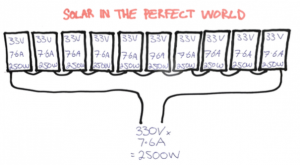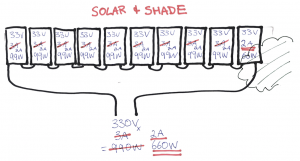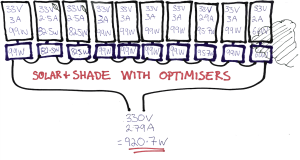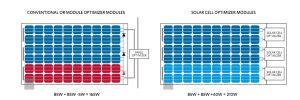Maxim optimiser review. Maxim Integrated panels are my latest find. Maxim is a brand of solar panel optimiser that is going to challenge the conventional optimiser market. In this review, I’ll first explain why optimisers are needed, what optimiser options are currently available, and finally why Maxim optimisers are the next generation in an exciting technology known as Module Power Electronics (MLPE).
Maxim optimisers shade proof your solar. Shade resistant solar? Seriously? Let me explain by starting with why solar panels are so drastically affected by shade.
Update: June 2019. While Maxim is a great concept in theory, in the field they had serious TV reception issues. We installed 25 Maxim systems and had TV Reception issues with 13 of them. Maxim has since pulled out of the Australian market. So what’s the next option?
Definitely not SolarEdge: Read my SolarEdge inverter review.
Huawei has an interesting but new product: Read my Huawei inverter review.
Tigo is my pick of the bunch: Read my Tigo optimiser review.
The review below give a simple explanation to why we need any type of optimiser, so it may be worthwhile reading on…
Solar in the perfect world
(Just read the italics quote below if you hate maths)
Solar panels are designed to work together. When we install 20 solar panels on a home, we usually run the first 10 in a “daisy chain” (in series) and the other 10 in another “daisy chain”. We call this “2 strings of 10”.
At lunchtime on a sun-shining day, a standard 250W panels will run at about 33 volts and 7.6 amps. If you multiply 33 x 7.6, you get about 250 watts. (volts x amps = watts)
When we string ten of the panels together, we multiply the 33 volts by the ten panels and get 330 volts. The amps (current) however, remains the same at 7.6 amps. When we multiply the 330 volts by 7.6 amps, we get 2500W.
Two of these strings give us 5000W or 5kW of power.
This was at lunchtime on a good day. At 8 am that morning when the sun was not so strong, we would still have about 33 volts per panel, but we may have (for example) only 3 amps. So 33 volts x 3 amps x 10 panels = 990 watts.
So earlier in the morning, voltage stays the same. However the current is less, and the power is less.
The current of a 1 panel is the same as the current of 10 panels in a string.
The real world problem
Enter the bad guy: Shady shade. Let’s say one panel is partially shaded by a tree at 8 am in the morning. When there is less sunshine on a panel, we have fewer amps (or current). Instead of 3 amps at 8 am we only have two amps.
The problem with a “daisy chain” of panels (in series) is that if one panel is shaded and running at 2 amps, then all of them will run at 2 amps.
Because just one panel is shaded, we only have 2 amps (instead of 3 amps) running through the entire string. 2 amps x 330 volts is only 660 watts. Partially shading just one 250w panel has lost us 330 watts! If we could just chop down the neighbours damn branch, knock down the next door’s building, or move that mountain, we would be back to our 990 watts. The one shaded panel “drags down” the power in the rest of the string.
Even if there is not a tree or building in sight, this entire string loss can occur when one panel is dirtier than the other. It also happens when one panel operating slightly lower than the others because of a variance in panel degradation and manufacturing mismatch.
Because the current in one panel is the same as the current of all 10 panels in that string, partially shading just one 250w panel (and reducing the current of that one panel) has in turn lost us 330 watts – or, 1/3 of our production in that string of 10 panels.
.
The solution
We need a way to make each panel to work independently of each other. There have been ever-improving methods of solving the shading problem. The solutions are collectively called “Module Level Power Electronics” or MLPE. In other words – we fix this problem at the solar panel with some type of electronics. Module level power electronics can come with several other advantages:
- It allows every panel to work independently of each other. One dirty, shaded or mismatched panel will not affect the next.
- It allows for much greater design flexibility. For example, if we need to install 3 panels on the North and 7 on the East, we can only achieve that with some type of MLPE.
- It can allow for individual panel monitoring. This way, if one panel is particularly shaded, dirty, or faulty – we can pick that up remotely and be proactive about fixing it.
- It can allow for a higher degree of safety by switching off the power at the panel on the roof rather than at the inverter on the ground. This is a great advantage in case of a fire.
.
.
MLPE Evolution
Module level power electronics is evolving. These are the stages of the evolution as I see it.
Solution 1: Bypass diodes
Bypass diodes have been in solar panels since Adam was a boy. They exist in just about every solar panel. If a tree is completely shading one panel, that panel will just be bypassed, as if it was no longer in that string. So if you threw a blanket over one of the ten panels, the other nine would work as normal. The problem that bypass diodes are only designed to kick in when there is a serious shading issue on one-third or more of a panel. While shade can sometimes completely blank out just one solar panel, panel mismatch due to soiling and degradation only partially affects the panel. Bypass diodes do not help solve soiling, mismatch or scattered shade.
Solution 2: Micro-inverters
Some clever cookie came up with micro-inverters to solve the problem. Instead of “daisy chaining” 10 panels together and sending 330 volts down to an inverter on the wall, they made ten small inverters and put them behind each panel. The panels are no longer daisy chained so the problem is solved. The added benefit with micro-inverters is that we can monitor every panel individually. If one of your panels is running 10 percent less, then you know you have a problem with shade, dirt, or (less likely) your panel needs to be replaced under warranty.
The problems with micro inverters are complex, and I discuss Enphase micro-inverter limitations in this blog. In short, micro inverters often cause significant design limitations which will decrease your power production. It’s also reasonable to assume that putting so many electronics in a little case on a hot roof will be less reliable than having those components in a central location in the shade and on the ground.
On the odd occasion, micro-inverters will help us with the best design at an affordable price. In these cases, we strongly recommend Enphase micro-inverters over their nearest rival APS.
Solution 3: First Generation Optimisers
Optimisers solve the issue by dividing the inverter. They place part of the inverter on the roof, but they want the other part on the ground. A typical solar Inverter is primarily made up of 2 parts: the MPPT and the inverter itself.
- The MPPT or “Maximum Power Point Tracker” is the part that tracks the slightly changing voltages and rapidly changing currents, and adjusts so it gets the maximum power out of the panels.
- The inverter “inverters” (transforms or changes) the solar panel DC power into 240v AC power so it can be used by our appliances.
To solve the issue of having too many parts on the roof, companies like SolarEdge and Tigo use what is called “panel optimisation”. Instead of putting the entire inverter on the roof, they just put the MPPT on the roof and leave keep the inverter on the ground.
There are several manufacturers doing this, the two I choose to work with are SolarEdge and Tigo.
- SolarEdge offer a whole solution. They sell the optimisers go behind each solar panel and a simple SolarEdge inverter without the MPPT. The system comes standard with individual panel monitoring. Solar Edge also has a higher level of safety because the panels shut down to a safe voltage in case of emergency.
- Tigo just sell optimisers. They are “inverter agnostic”. In other words, we can use any brand of inverter we like. In fact with the Tigo TS4 solution, if only a few panels are likely to be shaded, you can just purchase a few optimisers, reducing the overall cost of your solar system. They call this selective deployment. To reduce costs further, individual panel monitoring and safely isolating the DC power comes as an optional extra. Read my Tigo TS4 optimizer review.
Both of these solutions are great. SolarEdge is more expensive and is better. Tigo is more affordable if you use selective deployment and leave out individual panel monitoring and “Safe DC”.
Now, there is now another solution
Solution 4: Maxim Integrated panels
If I had my way, I would install a complete Tigo & Fronius systems or SolarEdge system on every roof with shading issues. Panel optimisation increases solar production in every situation. The fact that we can monitor individual panel production, and shut the solar panels down in case of a fire geeks me right out. But solar is about a return on investment. It’s for this reason that we have introduced the more affordable Maxim integrated panels to our line-up.
.
What is Maxim?
Maxim is the second generation of panel optimisation. It’s a simple and cost effective solution that does one thing, and one thing extremely well – panel optimisation. While Enphase, SolarEdge and Tigo all give the option of individual panel monitoring and a higher degree of safety, Maxim focuses on the main problem : not all panels in a string will always operate at the same current.
How Does Maxim Work?
Maxim simply works by taking those old fashioned bi-pass diodes out of the panel and replacing them with Maxim chips – or fairy-dust. It’s a bit above me how fairy dust works, but I can tell you what it does. It increases the current of a shaded panel to match the current of the others. It does this by lowering the voltage of the panels. If it didn’t lower the voltage, that little chip would be generating power all by itself, and we all know only Tinkerbelle’s fairy-dust can do that. And I don’t believe in Tinkerbelle.
The solution is elegant and affordable. There no increase in the number of components on the roof, so less parts to potentially fail. Even better, it means I can still use the Fronius inverter, that, although it does not have individual panel monitoring, it has a fantastic individual string monitoring and load control with the Fronius Smart Meter as I explain in this post.
But Maxim is even better!
I promised that Maxim would be “the closest thing to shade proof solar”. Here’s why:
Micro inverters and first generation optimisers both work at the panel level. If a bird makes a mess on one cell, the production of the whole panel is affected. But panels have always been divided up into three groups of cell-strings. As mentioned earlier each of these strings have always been protected by bypass diodes. Because maxim removes these 3 diodes and replaces them with Maxim fairy-dust, a maxim panel works at the cell-string level or one-third of a panel. If a bird does his business on one of your cells, then the whole panel is not affected – just one-third of the panel. So the Maxim panels actually work more efficiently than micro-inverters or SolarEdge optimisers.
Is Maxim fairy dust real?
My specialty is not electronics. But after reading the Maxim Optimisers White Paper, I’m convinced enough that I have ordered a container of these fairy dust embedded panels from my local solar wholesaler. I’ve waited 7 long months for this delivery, and as soon as it comes, an array of panels will be on my warehouse roof to make sure they work as the whitepaper says. If not – I’ll return them and have a quiet cry.
But if Maxim works as described – and I’m confident they will – then we’ll be introducing the next step in the evolution of solar panel optimizers to the Australian market.
Update. It took me six months, but my test results are in! Jump over to my Maxim test results to find out how it went. As a hint, we’re still installing Maxim.
.
Conclusion
Solar is an exciting industry to work in. The problems of shade have already been adequately solved by Enphase, SolarEdge and Tigo. If individual panel monitoring is high on your wish list, then you’ll need to fork out more and stay with the earlier models of Enphase, Tigo, or SolarEdge. But if optimisation and value for money are key, then Maxim are offering an affordably priced superior optimiser.
What are your thoughts on Maxim Vs other solutions for MLPE? Leave a comment and let us know your experience.
Mark







4 Responses
Hi Lindsay. The best thing to do with panels in the shade is retro-fit Tigo TS4 optimisers. I have a basic post on Tigo optimisers but am working on a more in-depth post at the moment. Wait till you read that. I’m trying to find issues we may get with different roof layouts.
Hi Mark, very nice post. In our current solar system layout, there are about 2-3 panels in the west site will be in shade in the morning (before 10am) while the rest of the west panels (7 panels) are totally exposed to the sun. Is it better to remove these 3 panels or install 10 optimizers for all the west panels? Thanks!
Hi Dan, Yes if they are significantly shaded, then that could help. However, when you have hard shade (eg from a building) your bypass diodes may be doing as good of a job.
hey mark, this is great! in summer i have 2 panels fully shaded facing north (out of 14) on a string (6 on the other string facing west), would it be beneficial to get 2x ts4 optimizers installed on those 2 only? I live in mitchelton. thanks